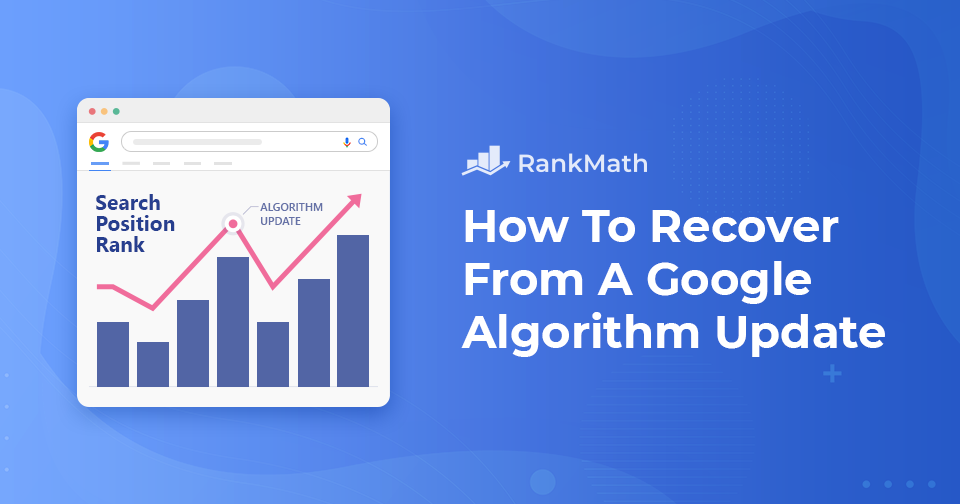Google announces an algorithm update and your site is starting to show signs of being affected – now what?
Are the two even related? We’ll cover all that & more in this complete guide to dealing with & recovering from Google algorithm updates the right way…

Remember – Why Do Algorithm Updates Happen?
Google’s March 2024 Core Algorithm Update is a great example.
Unlike many of the updates that are speculated to happen throughout the year, this was a confirmed algorithm update which means that Google themselves issue statements about the update. However, since it is a “broad core update” – meaning that it is not specific to a region, language or website category, there is no specific guidance passed on from their end or any suggestions as to what it is aiming to address.
Basically meaning that the goal of the update is simple: help Google get better at assessing content and determining what pages serve the best answers for searchers across the board.
In such cases, Google has in the past typically only referred to their existing documentation/guidance on Core Updates which is that there isn’t necessarily anything fundamentally wrong with pages that may perform worse after a core update. The changes made to their systems are intended to issue improvements to how well it is able to assess content quality overall. If you’re interested in how we approach Core Algorithm Updates, as well as specific updates such as the Anti-Spam update – keep reading…
How to Know if Your Website Was Affected by & Determine the Impact of a Google Algorithm Update
Before you even start planning your recovery – you first need to figure out whether your site has been affected at all & in what way…
Confirm There Actually Was an Algorithm Update That More People (i.e. Not Just You) Are Observing
Fortunately, if you already use Rank Math (our SEO plugin for WordPress) this is incredibly easy to do since we overlay both confirmed & unconfirmed algorithm updates in Rank Math Analytics – as well as on our website so it’s extremely easy to follow along and access any information relevant to updates including but not limited to:
- Any official statements made by Google
- Comments from throughout the SEO community
- Insights & general trends that seem to be as a result of the update
- and more…
Though do note that especially for the unconfirmed updates – it can take a few days (at the very least) after you start to observe some of your sites being affected for them to show up.
Refer to Your Analytics Data
Now that some time has passed and you’re more likely to be able to come across useful insights when diving into Google Analytics & Google Search Console data – here’s how you can generally make the best findings:
Using Rank Math Analytics (Quick & Easy)
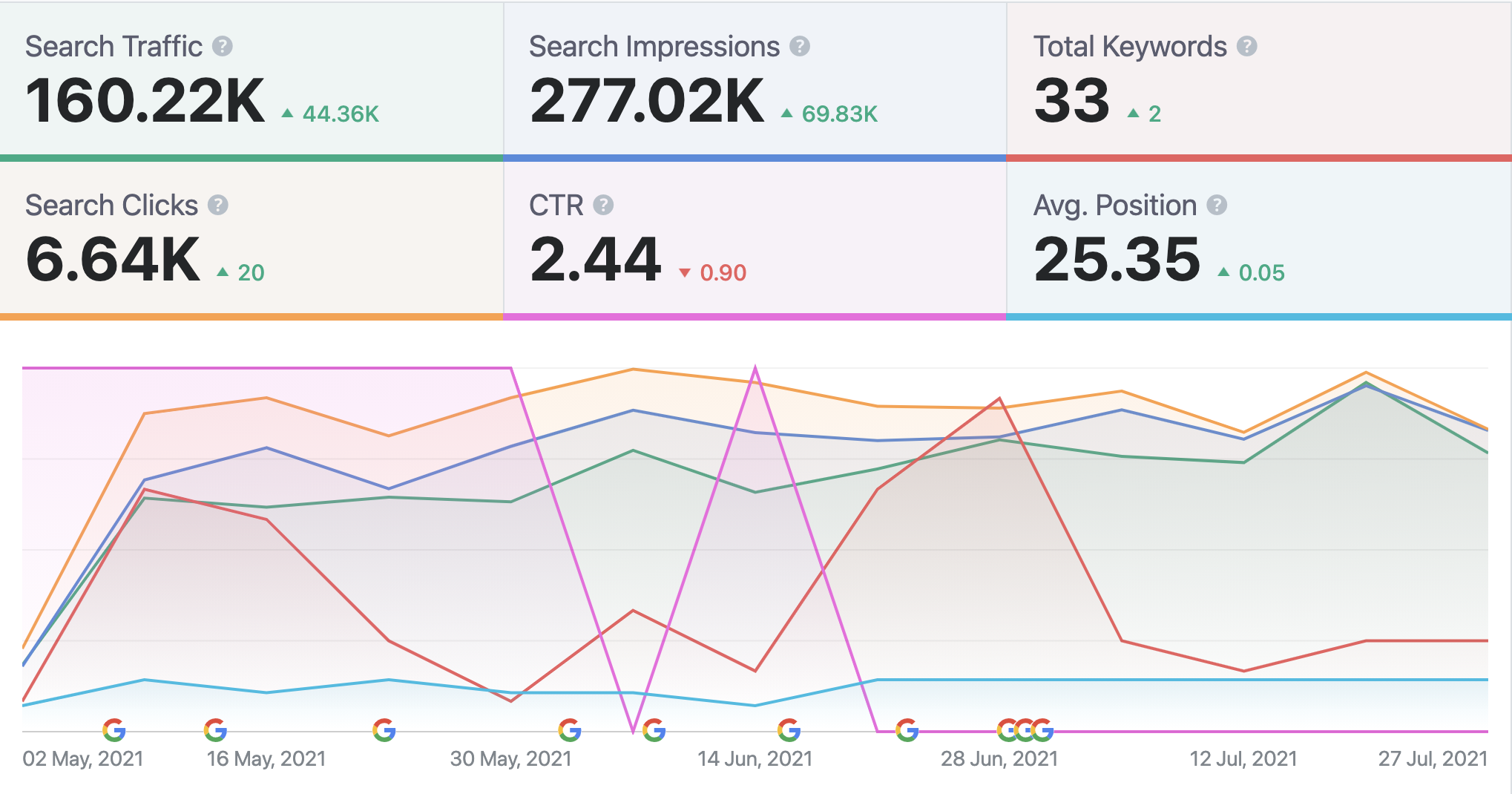
Rank Math’s Analytics module makes it incredibly easy to access the relevant data from Google Analytics & Google Search Console in an extremely easy-to-digest fashion as well as with both confirmed & unconfirmed Google Algorithm Updates made accessible all in one place.
Learn more about how to monitor Google Algorithm Updates with Rank Math here.
At a glance, you’ll be able to access data including your top 5 winning & losing keywords & much more.
All along with the ability to filter Google Search Console and Google Analytics data that is pulled into these Rank Math Analytics reports by country.
This is incredibly important and helpful when diagnosing the effect of Google Algorithm Updates as depending on the target audience of your site looking at worldwide data can often skew or make data look unaffected with variance in data for each of your target markets that naturally occurs.
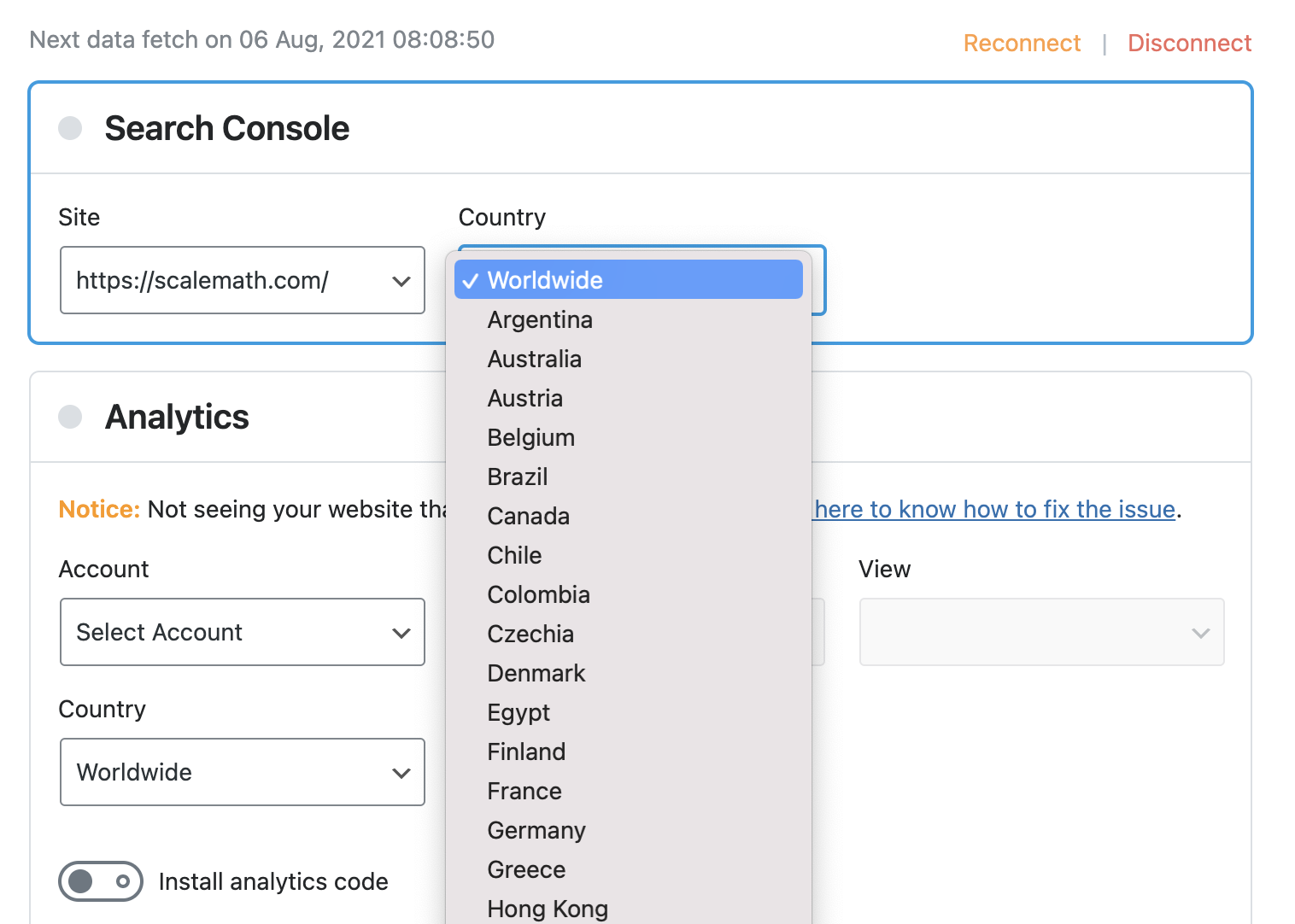
Using Google Data Studio (Advanced)
If you want to dive even further into the data behind your site and have the time to spend doing so – here’s a neat Google Data Studio template useful for post-algorithm update analysis.
Note: If you’ve never used Google Data Studio in the past and setting it up sounds daunting, this really isn’t a necessary step and is in large part why we built Rank Math Analytics. To make your Google Analytics and Search Console Data more accessible so you can actually dive into reports and pull out the useful data without having to spend hours doing so and overwhelming yourself in the process.
What you’re able to achieve with Google Data Studio is relatively comparable to the way the same data is presented in Rank Math Analytics. So this is a great solution for those of you who aren’t currently using the world’s leading content management system (WordPress) for your websites.
And, you’re also able to filter out specific affected queries to see if there are any trends regarding which are winning or losing similar to that of Rank Math’s top winning and losing keywords report.
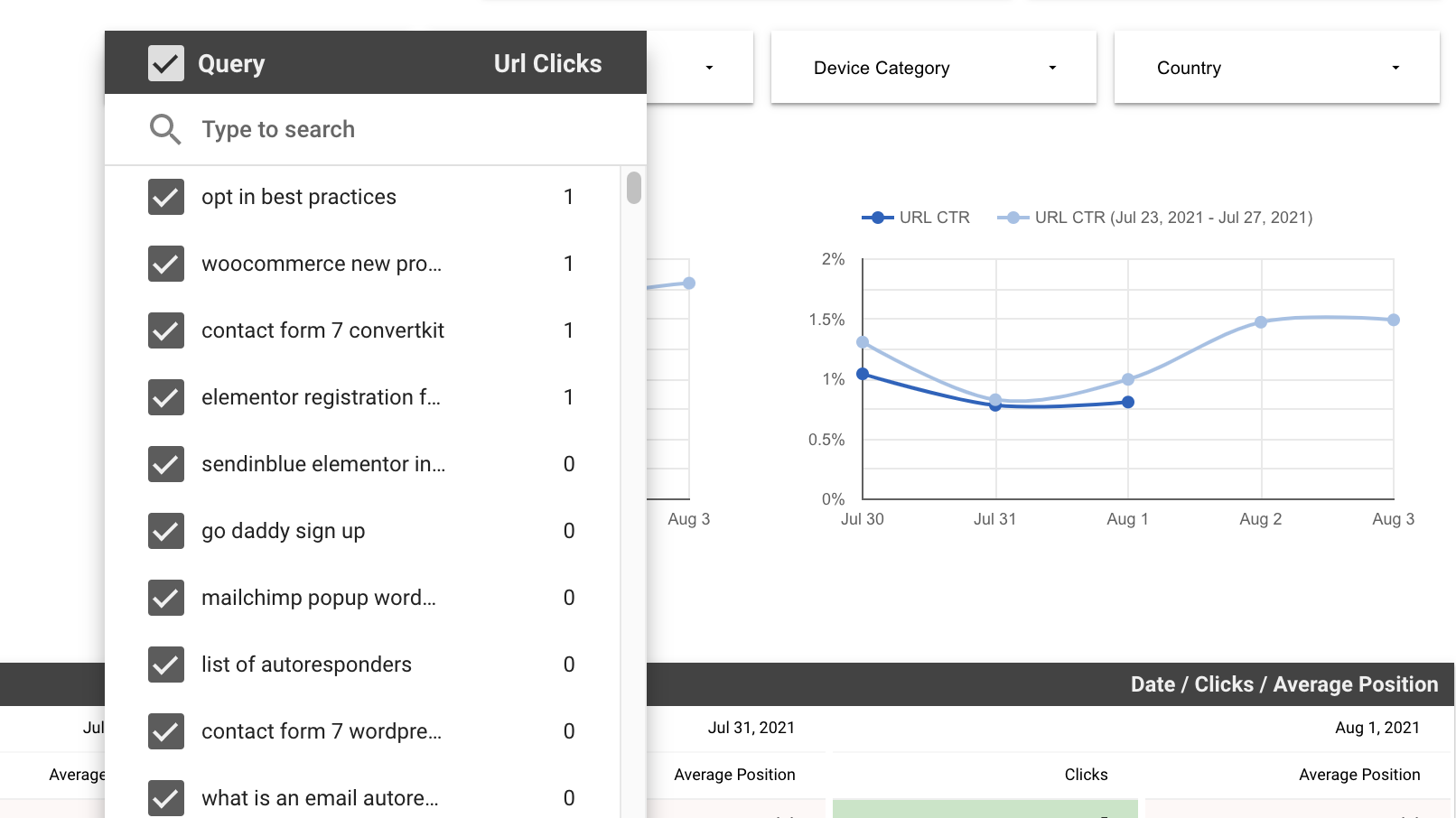
1 How to Recover From Google’s Broad Core Algorithm Updates
This might sound like a given, but the step before the actual first step really is to try not to panic.
Because panicking leads to overreacting which then leads to making decisions quickly based on instinct rather than what the data has to suggest.
So take a moment to step back, discuss with other friends in the industry that have (as well as those who haven’t) been affected.
Then you can start planning how you intend to address the changes, and in any case – you should always be comfortable turning to communities. Communities, real support networks like the Rank Math SEO Facebook Group truly are your superpower so that even in situations where it feels like you’re working all on your own in an isolated situation, you actually aren’t.

And last but not least, take a step back to consider the actual impact of this Google Algorithm Update on your bottom line (how serious of a situation are you in as a result), are you in a position where revenue has been significantly affected to the point where your SEO & marketing budget has too?
Or are you only starting to observe effects on search engine rankings (and traffic as a result) but have a business model that has been built in a way to sustain situations like this and is able to continue operating without issue/dedicating the resources needed to take the steps necessary to recover?
1.1 Evaluate the Actual Purpose of the Update (i.e. What is Google Trying to Address?)
Earlier we covered how to go about determining whether and to what degree a Google Algorithm Update has affected your website.
Fortunately, that is also the first step in evaluating the update’s actual purpose. Now we know that Google’s take on all of its updates is that it is to improve the quality of search results, which is the case, but this alone isn’t enough to make a decision as to what elements of your site to focus on and invest in.
In some cases, although not often – you will see Google themselves confirm the area of interest for algorithm updates. One such example is the recent new spam algorithm update from June of 2021. Exact details, as expected, were still not provided but Google’s Danny Sullivan did confirm the algorithm update was focused on fighting spam.
1.2 Identify Patterns – Evaluate Whether Specific Segments or Types of Content on Your Site Were Affected
Now it’s time to dive into analytics data and see if you’re able to identify any patterns. Is there a specific pattern type of content or certain content which has observed significant declines?
This can help determine the cause of the update as well as start to formulate an idea of what the logical next steps/improvements to your site should be.
So, it’s time to go through your traffic by post (and page). This is extremely easy in Rank Math Analytics using the Top 5 Losing Posts functionality:
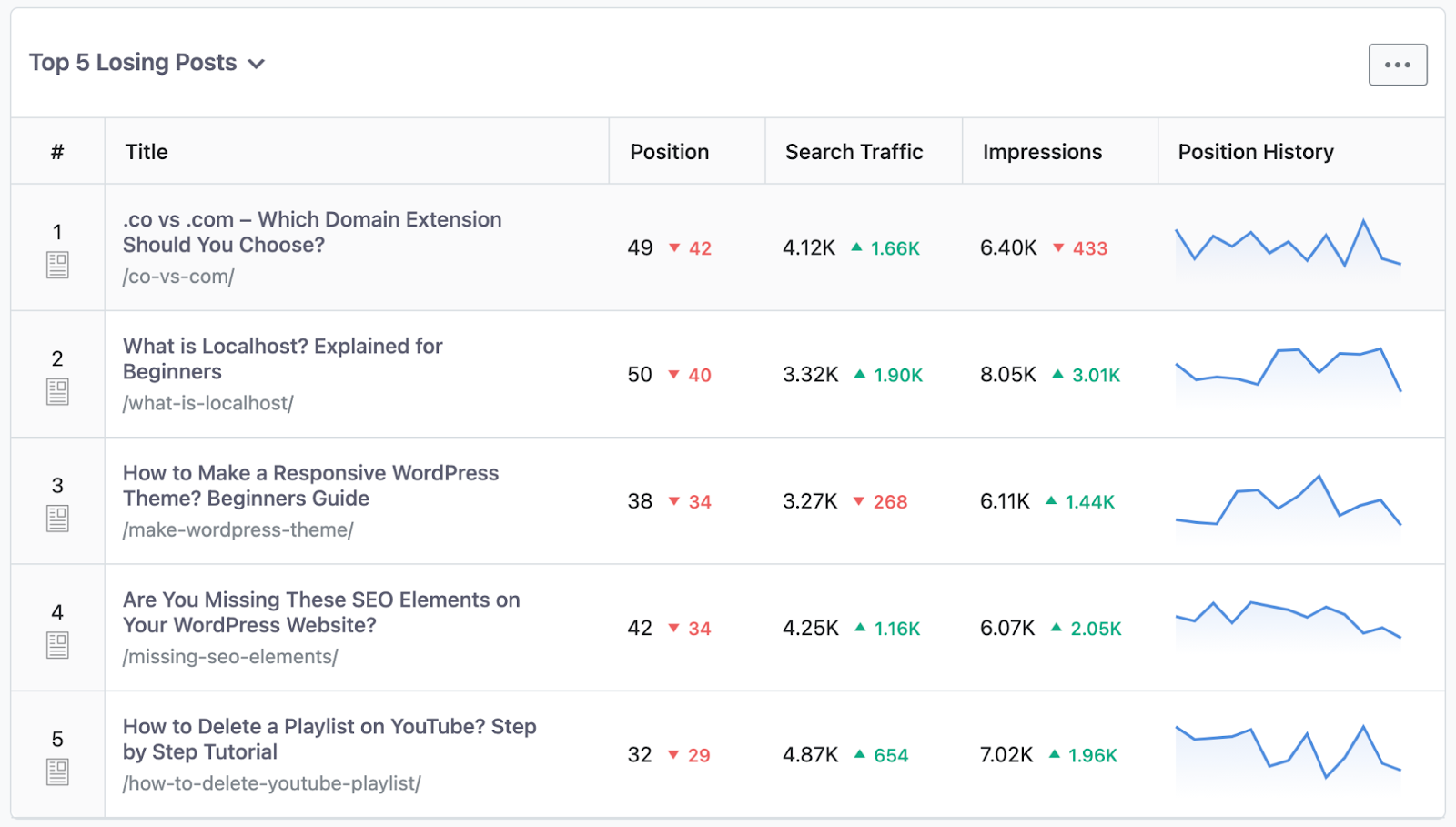
In Google Analytics 4, this trend data is a little more difficult to locate but is also available when you navigate to Acquisition → Traffic acquisition:
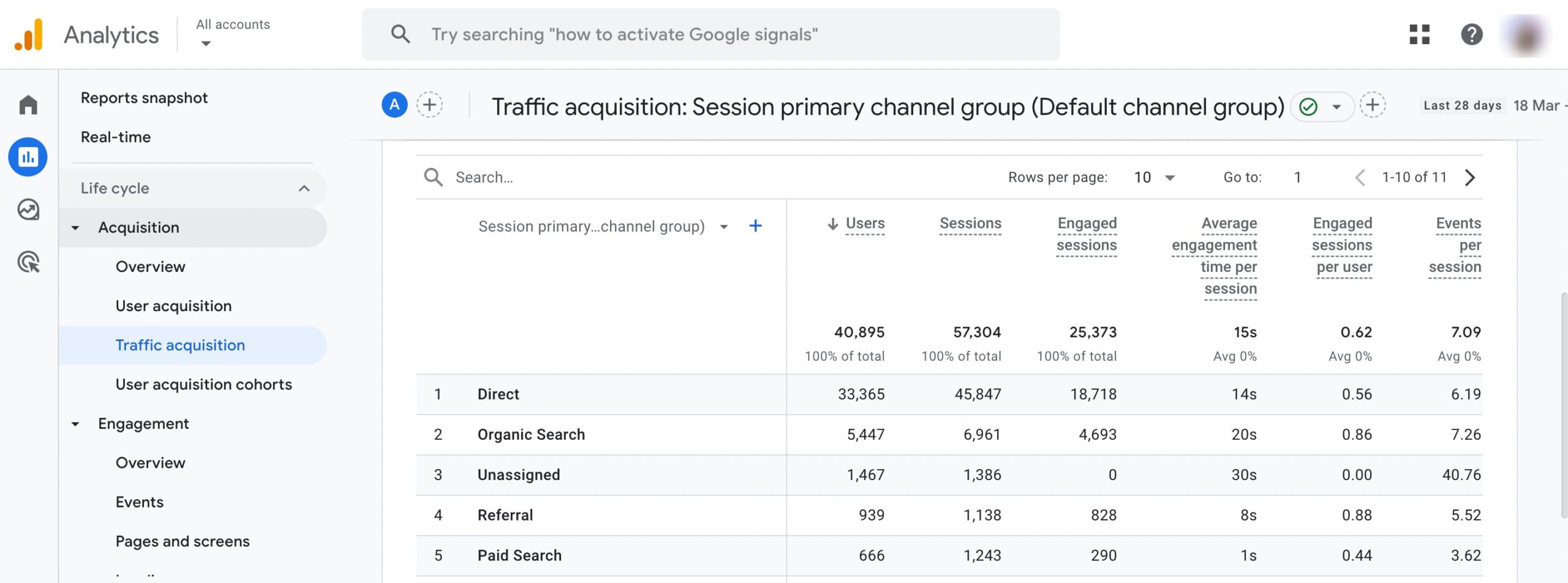
Here you can segment organic traffic by search engine. Next, select All Users and add a comparison by choosing the First user source/medium dimension, as shown below.
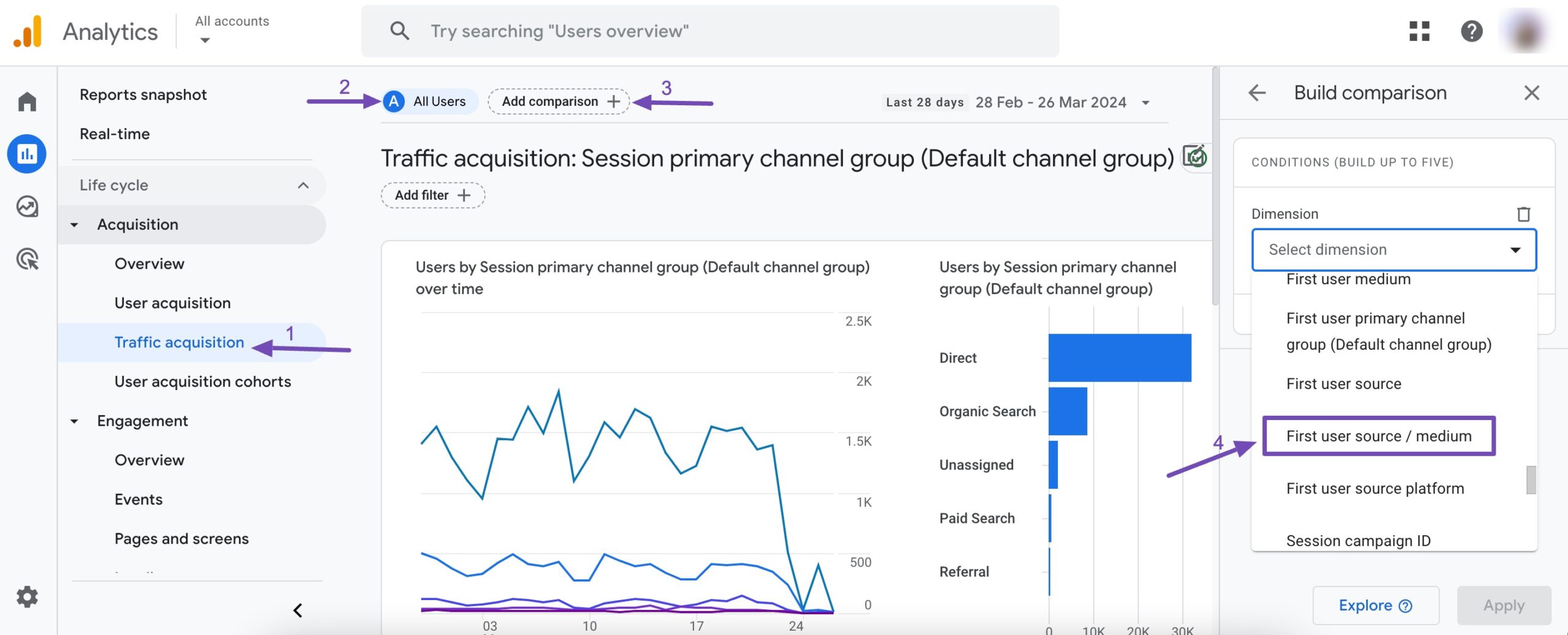
You can now select the organic search channels you want to include from the dropdown menu under Dimension values. This can include all organic traffic from different search engines, or you can set specific benchmarks for each search engine like Bing, Yahoo, or Google.

Select the Start date and End date, and you’ll now be able to view the total organic search traffic from the previous month.
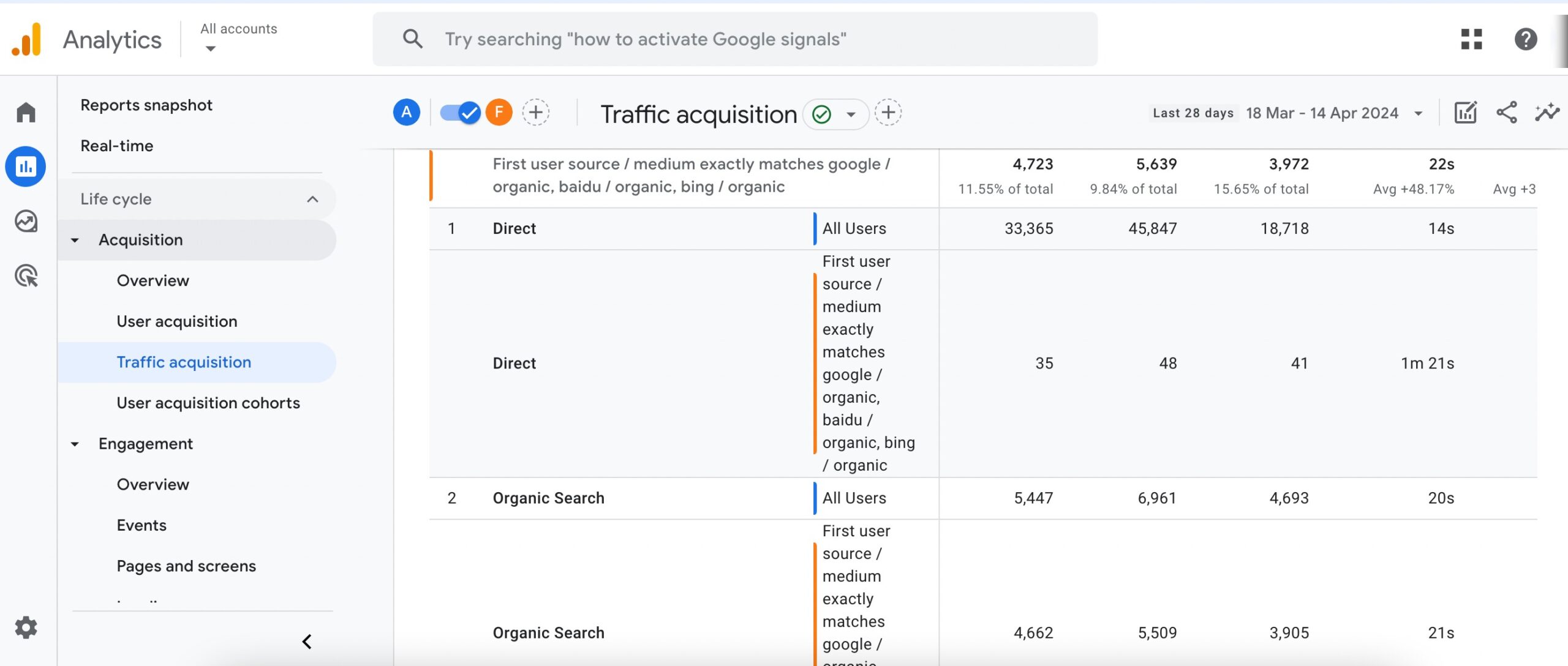
That way you can start to see if there were specific pages that were affected that you’d want to dive in to have a closer look at to see whether it was in fact even organic traffic that affected those posts (or traffic from other sources that suddenly dipped).
At this stage, you will also be able to observe whether the update has had an effect on a handful of previously high-ranking posts on your website as opposed to perhaps your entire website. If the effect was sitewide, this would typically be an indication of a quality issue on your whole website that your site’s only now been hit by (which could even be E-E-A-T related)…
1.4 Evaluate How Your Top 5-10 Competitors Were Affected
If your website traffic has taken a hit as a result of an update, it means that other sites must be earning the traffic you previously were.
Simply put, the number of people searching and the number of searches they’re performing isn’t directly affected by an update. So, if your website’s traffic has declined it’s going somewhere else instead.
Remember: An update doesn’t necessarily mean that your website is being penalized, it’s actually more often the case that previously under-recognized websites are only now being surfaced in search.
Now, this may come as a surprise but a good way to find out is to – perform some Google searches of your own.
- Are you able to observe any changes?
- What companies/websites are ranking where your site used to be and is there anything distinctly different about their approach?

Performing SERP analysis manually will let you zero in on the SERPs for specific searches so we highly recommend that approach.
That being said, Semrush and SimilarWeb also provide data that can be useful in determining how other websites across the web have been affected so that you can start to evaluate their content and form an understanding of why:
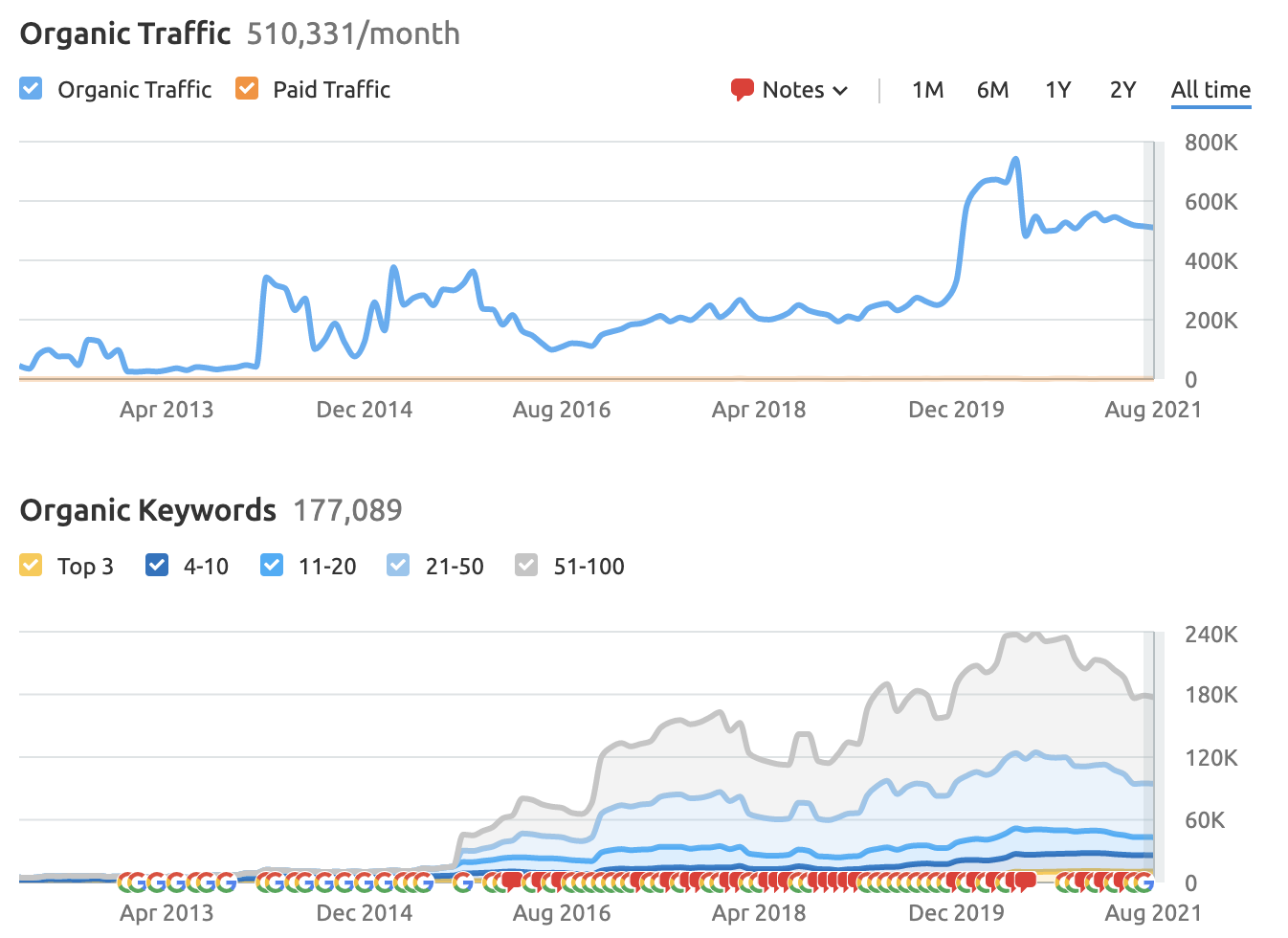
In other words, is the content that is now outperforming you & outranking you (that has resulted in your site being affected) just content that’s more trustworthy – meaning that Google found a better piece of content that wasn’t outranking you before but should have been.
1.5 Plan & Prioritize What to Focus on Addressing
Now that you know what’s changed and what’s wrong with your content – so, the next step is simple. Simple, not easy. Start planning and prioritizing what you want to approach first based on what you think is likely to have the biggest impact.
When looking at your content and comparing it to the content that is now all of a sudden outperformed by other content – this is where one of Google’s major updates (E-E-A-T) comes in. E-E-A-T in SEO stands for Experience, Expertise, Authoritativeness, and Trustworthiness. It’s a concept that’s covered in great depth in Google’s own Quality Rater Guidelines. This continues and will only continue to increase in importance as time goes on and more websites begin to take E-E-A-T into consideration. We’ve seen quite a few sites that have been negatively affected by Google Algorithm Updates as a result of a clear lack of E-E-A-T.
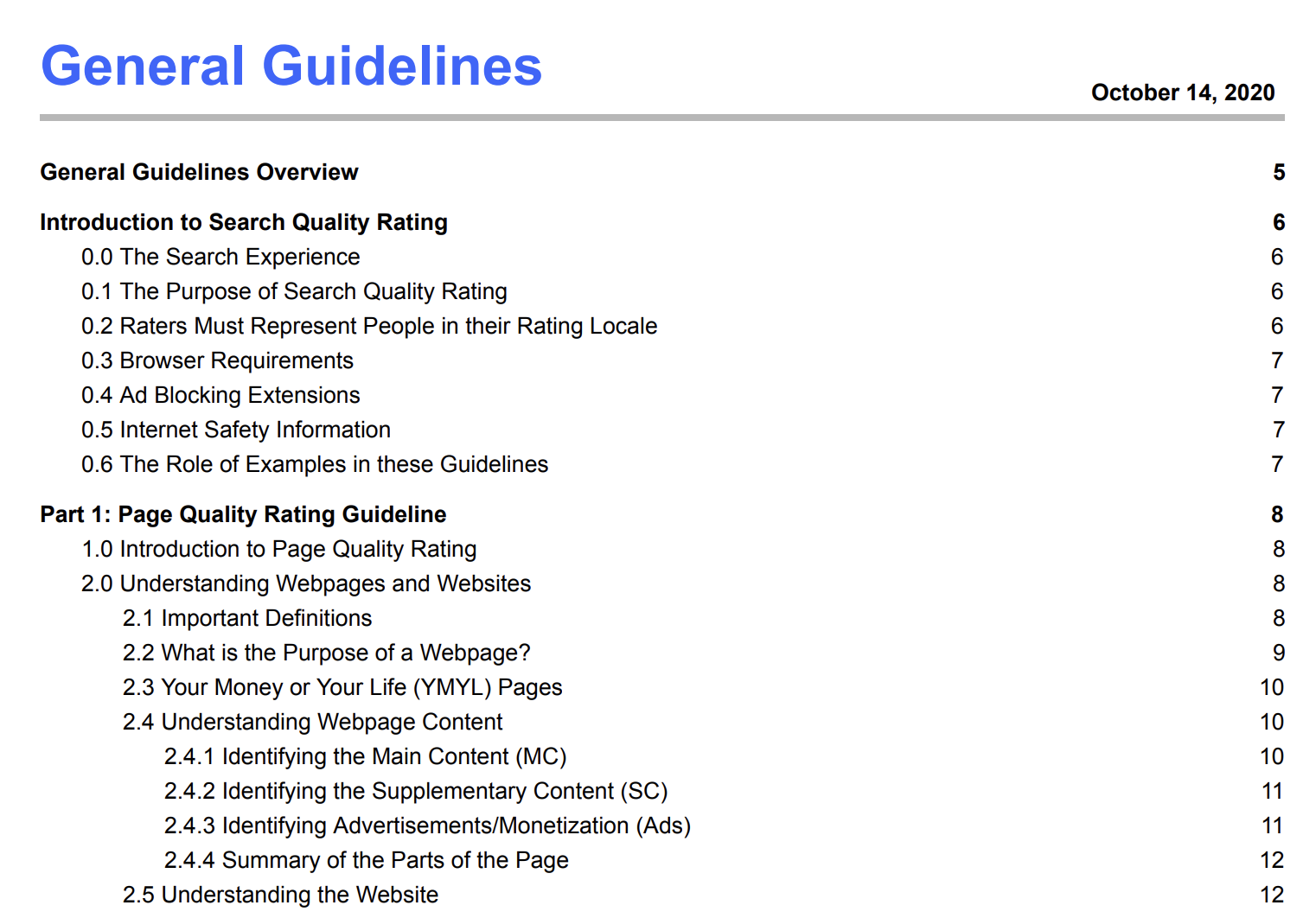
Google’s very own documentation has actually stated “the amount of expertise, authoritativeness, and trustworthiness (E-E-A-T) is very important.
This includes:
- The experience of the creator of the content
- The expertise of the creator of the content
- The authoritativeness of the creator of the content, the content itself, and the website as a whole.
- The trustworthiness of the creator of the content, the content itself and once again the website as a whole too.
You can observe a variance in the importance of this depending on the industry, with those getting closer to the YMYL (your money or your life) category of sites – meaning those which help people make important decisions – rightfully observe the most weight being given to E-E-A-T.
Google and various members of their team on numerous occasions have summarized this to “have great content”. At the end of the day, this is what truly remains in your control, with Google change is a given so trying to fight it isn’t worth it but what you can control is the amount of time, effort, and resources dedicated to making your website the best resource on the internet (such that it is truly one that without a doubt deserves to outrank your organic search competition).
2 Google’s Take on Recovering From Broad Core Updates
“What does Google say to do about recovering from core updates? Is recovery possible?”
The “million-dollar” question as many would put it. Year after year, sites succeed through core algorithm sites and sites are tanked (sometimes entirely) resulting in the loss of millions of dollars worth of potential income.
Yet, the reality is that Google says there is nothing you can to do truly recover from core updates which is true. As you’ll observe from our strategy to developing an actionable approach to make a comeback for your website – there really aren’t any quick fixes that allow sites to see a quick recovery. Google actually has recommended that webmasters should avoid trying to mistakenly try to change things that aren’t actually issues.
This is not to be misconstrued as “there is no way to recover from core updates” as that’s simply untrue – many sites have recovered over the years & managed to weather the storm as some may call it that is a core algorithm update. Was it easy? No. Was it overnight? Also, no.
Recovery takes significant time, effort, patience (and let’s not forget – resources).
3 How to Prepare Your Website & Your Business for Future Algorithm Updates
Now let’s discuss how you can future-proof your business model and ensure that your website can’t be significantly affected by an algorithm update. Because while this is not directly related to recovering from Google algorithm updates – we honestly consider it an essential part of every business and the collaboration between SEO, marketing & product teams.
3.1 Diversify Your Traffic
Even if your website is a publication, although the organic search is truly the best source of consistent, scalable traffic – it shouldn’t be the only source of traffic and revenue for your business, but we’ll talk more about revenue later.
3.2 Build a Following, Grow an Audience
When your whole business model is people land on your site only for the terms you rank, forget about you until the maybe rank on your website at some point again it’s a lot more fragile than if you set your website (and business) up to encourage visitors to return to your website.
And the key to this is really building a following and growing an audience. Not only does this make many elements of SEO, including off-page SEO (i.e. content promotion) easier, it’s also going to be a great source of new traffic.
The four channels we can highly recommend investing time/resources in are:
- Building an email list
- Starting a YouTube channel
- Growing an audience on Twitter
- And maybe, if it makes sense for what you do – and when your audience is big enough starting a Facebook community for your brand (perhaps comparable to the way we use our own Facebook Group to help & bring people in the industry together)
3.3 Build a Business So Good, So Important That It Doesn’t Rely on Search (Or Anything) in Particular to Survive
Very few businesses ever reach this stage so this is not intended to suggest that you are going to be able to make this happen overnight, but the truth is that if the business you’re building has a greater purpose, truly helps people achieve something that they’re willing to spend money for and that need is unaffected by anything that’s not in your control (i.e. not seasonal, not by search demand). Getting to this stage as a company is incredibly difficult but if you make it, while Google algorithm updates may reflect a slight dip in your growth trajectory, you’ll always be able to dedicate the resources necessary to come back even stronger and use updates as an opportunity to make your site even better.
3.4 Diversify Your Income Streams
Somewhat related to the concept above, but much easier to achieve is the diversification of your income streams. Views on what level of diversity to aim for with income streams is varied, with some saying that no one thing should ever be the source of over 50% of your income and others even going as far as to say as 5% of your income.
Initially, this will be a long-term initiative to work towards and you will likely have one specific source of income (this is entirely natural and not a problem), but investing in developing other sources of income will also help protect you from future algorithm updates (especially if 3.1 and 3.2 are also still in the works and your business is still heavily reliant on organic search to stay profitable).
4 Frequently Asked Questions
How Often Do Google’s Updates Happen?
The information available suggests that in order for Google to keep results relevant and as helpful as possible they are updating systems very frequently. With “only” 350-400 changes back in 2010 (one per day) but closer to 3,200 back in 2018 – suggesting that today in 2021 they are averaging multiple changes per day.
What is a Google Broad Core Algorithm Update?
A Google broad core algorithm update is when Google issues a change to the way in which they assess and rank content in general. This is different from updates like the Penguin and Pigeon update. As the Pigeon update, for example, was specifically designed to address local SEO spam.
How Do I Know if My Website is Affected by a Google Update?
Keeping track of your website or multiple websites if you have more than one can be extremely time-consuming. We recommend checking on your organic search performance indicators once per week and in detail once per month. To make the entire process as hands-off as possible, you can take advantage of SEO Email Reporting – a feature that’s built right into Rank Math if you use WordPress.
If your site doesn’t run on WordPress, you can alternatively use services like Ahrefs, Semrush, or Google Search Console Insights.
What is the Best Way to Keep Track of Google Algorithm Updates?
The best way to keep track of Google algorithm updates if you use WordPress is using the Rank Math WordPress SEO plugin and taking full advantage of what its Analytics module has to offer by upgrading to Rank Math PRO.
Other ways are to join SEO communities as well as subscribing to SEO newsletters and joining conversations on Twitter (we’re @rankmathseo by the way) to keep track of people what SEO professionals who run growth for multiple websites are seeing with sites in different industries.
What is the Difference Between a Google Algorithm Update & a Penalty?
In short, a Google Algorithm Update is the change made to the way in which their ranking algorithm works, and being negatively affected by an algorithm change does not necessarily mean that your website has been penalized. A penalty on the other hand is when action is taken against a website as a result of a violation in Google’s Webmaster Guidelines. That being said, there are also algorithmic penalties which are when through no manual input from a Google employee a website is given a penalty.
5 After Action Report – Keep a Pulse on Your Sites With SEO Reports
Recovering from a Google algorithm update is no easy feat – there’s an entire service offering that many SEOs are profiting off of surrounding sites that suffer as a result of algorithm updates.
If you’ve worked your way through this detailed update recovery guide, you’ll be fully equipped to tackle any update that comes your way as well as to start preparing yourself (and your business) for the next algorithm update that is bound to come someday so you never have to worry about waking up to an update that’s tanked your site and your source of income.
Last but not least, we cannot stress this enough – keep track of your websites. Declines aren’t always sudden, they can happen over time. As the saying goes, if you’re not growing, you’re dying.
So, now that you’ve made it this far: go implement a reporting solution today so you can ensure you’re observing week-over-week and month-over-month organic search traffic improvements as well as keep a pulse on changes to your ranking for specific keywords that you know are important to your business.
Have any additional questions about recovering from an algorithm update you’d like us to cover in this post? Let us know by Tweeting @rankmathseo. 💬
